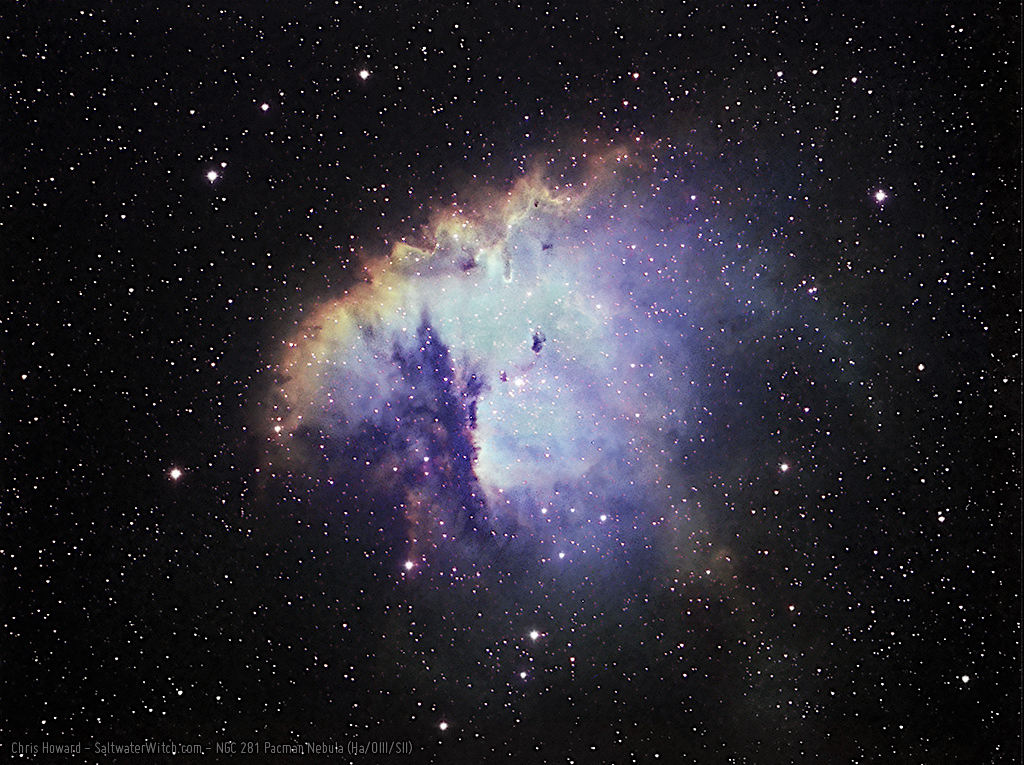Astro Gear: May 30, 2018
Narrowband imaging on the cheap?
 It's tempting to say "here's what you can expect from a $129 Hydrogen-alpha filter", but it's never as simple as that, is it? Perspectives and opinions vary, but I consider this a pretty good H-alpha narrowband shot of the Crescent Nebula (NGC 6888), with some great contrast--the Crescent structure itself stands out, and I still managed to bring in a lot of the surrounding dust and clouds of ionized hydrogen. I used an Astronomik 1.25" 12nm Ha filter, an Atik 414EX mono CCD, iOptron CEM25P EQ mount, and I took 4 x 1200 second subs + 15 dark frames, all stacked in DSS. I shot these frames from my backyard, on a clear night with good seeing (Bortle 4, SQM: 20.62 mag/arc sec² according to https://www.lightpollutionmap.info). I've never shot deep space objects with 6, 5, or 3nm bandpass filters, but a 2" Baader 7nm used to be my primary Hydrogen-alpha filter--and I loved it. When I started out in astrophotography I was thinking long-term and went with 2" filters for everything--and it cost me a bunch. A couple years ago I switched to 1.25" filters, both for cost savings and pairing with the smaller Atik 414EX sensor--2" wasn't necessary. It also allowed me to get the Atik EFW2 with the 9-position filter wheel, so I can run with LRGB, Clear, Ha, OIII, SII, near-IR all in one neat motorized package. Because I was looking to save to money I went with a cheap Ha filter--the Astronomik 12nm H-alpha runs around $130 USD. Very inexpensive when compared to the $300 2" Baader I used to use regularly, and nowhere near the $900+ Astrodon 3nm 2" filter. I'm sure the Astrodon kicks ass--they're one of the premier filter manufacturers. But do you need a $900 filter to shoot narrowband? If you have fairly dark skies in your neighborhood (or within driving distance), I would say absolutely not. Will it make things easier when it comes to increasing SNR in light polluted skies? Absolutely. Will it make things easier when it comes to increasing contrast and pulling in those fainter wisps of dust and hydrogen? Probably. But I wouldn't hold off on narrowband imaging just because you can't afford the best. There are just too many cool targets in the night sky that you're not going to pick up with RGB. And that's one of the advantages of our hobby. You can shoot forty subs tonight, stack, process, and post them, and then come back tomorrow, next week, or next year and reshoot the same target with a different camera, faster scope, or better filters. Some targets never get old, and if they do, there are mysterious absorption nebulae and integrated flux nebulae--and even crazier things in the night sky to pursue. Beyond that, there are always interesting new wonders below the horizon--or above, depending on which hemisphere you spend most of your time.
It's tempting to say "here's what you can expect from a $129 Hydrogen-alpha filter", but it's never as simple as that, is it? Perspectives and opinions vary, but I consider this a pretty good H-alpha narrowband shot of the Crescent Nebula (NGC 6888), with some great contrast--the Crescent structure itself stands out, and I still managed to bring in a lot of the surrounding dust and clouds of ionized hydrogen. I used an Astronomik 1.25" 12nm Ha filter, an Atik 414EX mono CCD, iOptron CEM25P EQ mount, and I took 4 x 1200 second subs + 15 dark frames, all stacked in DSS. I shot these frames from my backyard, on a clear night with good seeing (Bortle 4, SQM: 20.62 mag/arc sec² according to https://www.lightpollutionmap.info). I've never shot deep space objects with 6, 5, or 3nm bandpass filters, but a 2" Baader 7nm used to be my primary Hydrogen-alpha filter--and I loved it. When I started out in astrophotography I was thinking long-term and went with 2" filters for everything--and it cost me a bunch. A couple years ago I switched to 1.25" filters, both for cost savings and pairing with the smaller Atik 414EX sensor--2" wasn't necessary. It also allowed me to get the Atik EFW2 with the 9-position filter wheel, so I can run with LRGB, Clear, Ha, OIII, SII, near-IR all in one neat motorized package. Because I was looking to save to money I went with a cheap Ha filter--the Astronomik 12nm H-alpha runs around $130 USD. Very inexpensive when compared to the $300 2" Baader I used to use regularly, and nowhere near the $900+ Astrodon 3nm 2" filter. I'm sure the Astrodon kicks ass--they're one of the premier filter manufacturers. But do you need a $900 filter to shoot narrowband? If you have fairly dark skies in your neighborhood (or within driving distance), I would say absolutely not. Will it make things easier when it comes to increasing SNR in light polluted skies? Absolutely. Will it make things easier when it comes to increasing contrast and pulling in those fainter wisps of dust and hydrogen? Probably. But I wouldn't hold off on narrowband imaging just because you can't afford the best. There are just too many cool targets in the night sky that you're not going to pick up with RGB. And that's one of the advantages of our hobby. You can shoot forty subs tonight, stack, process, and post them, and then come back tomorrow, next week, or next year and reshoot the same target with a different camera, faster scope, or better filters. Some targets never get old, and if they do, there are mysterious absorption nebulae and integrated flux nebulae--and even crazier things in the night sky to pursue. Beyond that, there are always interesting new wonders below the horizon--or above, depending on which hemisphere you spend most of your time.
Short thread on this topic at Cloudy Nights: https://www.cloudynights.com/topic/612314-7nm-vs-12nm-h-a-filter
The general conclusion is get the narrowest bandpass you can afford, which is the right answer, especially if you have any light pollution problems.
Posted May 30, 2018
Astro Session - January 13, 2018
It's winter and that's when Orion is arguably the main attraction in northern hemisphere skies. HaRGB of the Horsehead Nebula (Barnard 33) along with the reflection nebula NGC 2023 (below and left), part of a whole neighborhood of nebulosity around the leftmost star in Orion's Belt, the blue supergiant Alnitak. (I kept Alnitak out of frame, but it would off to the left with a wider field of view). The Horsehead is an absorption (or dark) nebula about 1500 lightyears from Earth, and shows up so prominently because it's blocking most of the starlight behind it. (10 x 600 second Ha frames, 10 x 240 second RGB frames, 24 dark cal frames taken with an Atik414Ex mono CCD, William Optics GT-81 + 0.8x Field Flattener/Reducer f/4.7, iOptron CEM25P EQ mount, Astronomik 12nm Ha filter, Baader RGB filters, WO 50mm guide scope with ZWO ASI120S-MM guide cam, INDI/KStars/Ekos observatory control. Location: Stratham, New Hampshire, US. ~Bortle 4)

The full FOV for this shot:
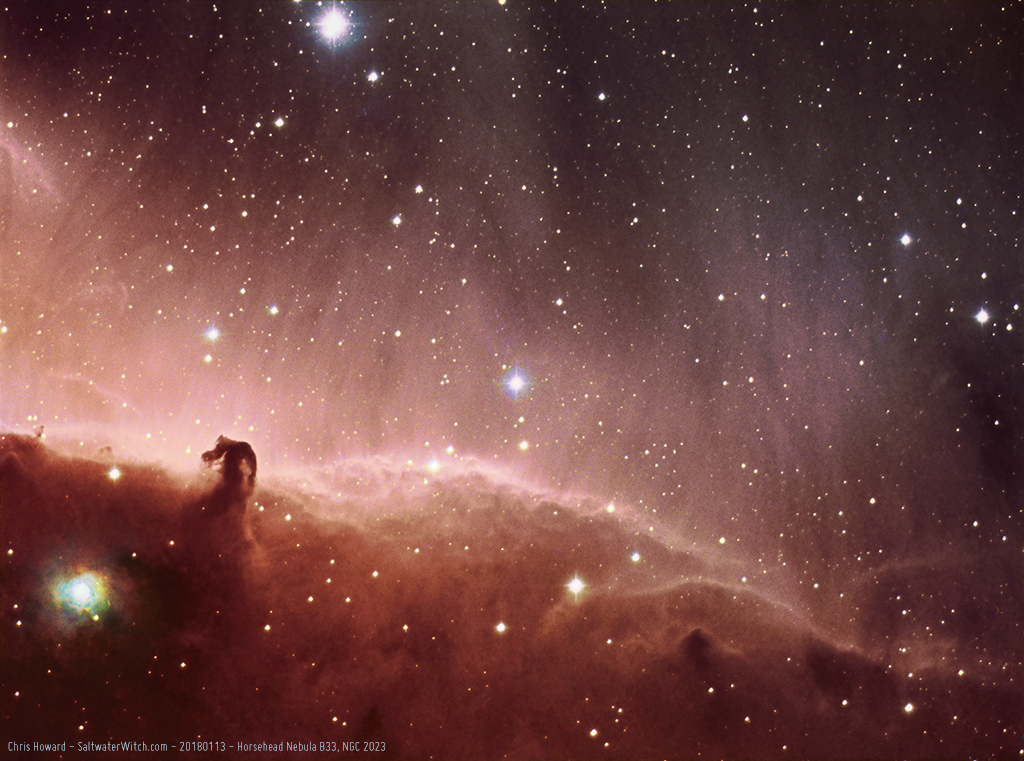
Posted January 13, 2018
Astro Session - December 27, 2017
California Nebula NGC 1499, an emission nebula in the constellation Perseus. Named after the Golden State because of the similarity in shape--and this is just the lower portion, basically Santa Barbara on down, although depending on how you match up coastline similarities you might be able to squeeze in everything up to Pismo Beach. I attempted to do some Ha + RGB color process stuff with this set, and I think it worked out. I overloaded the red channel to bring out some contrasting shades, and the GB didn't contribute much. NGC 1499 is mostly ionized hydrogen, and it's massive, almost 2.5°. I'd have to take two or three combined shots to get the whole nebula in one image with the camera+telescope FOV of my setup: Atik414Ex mono CCD, William Optics GT-81 + 0.8x Field Flattener/Reducer f/4.7, CEM25P EQ mount, Baader and Astronomik filters, WO 50mm guidescope with ZWO ASI120S-MM guide cam, INDI/KStars/Ekos observatory control.
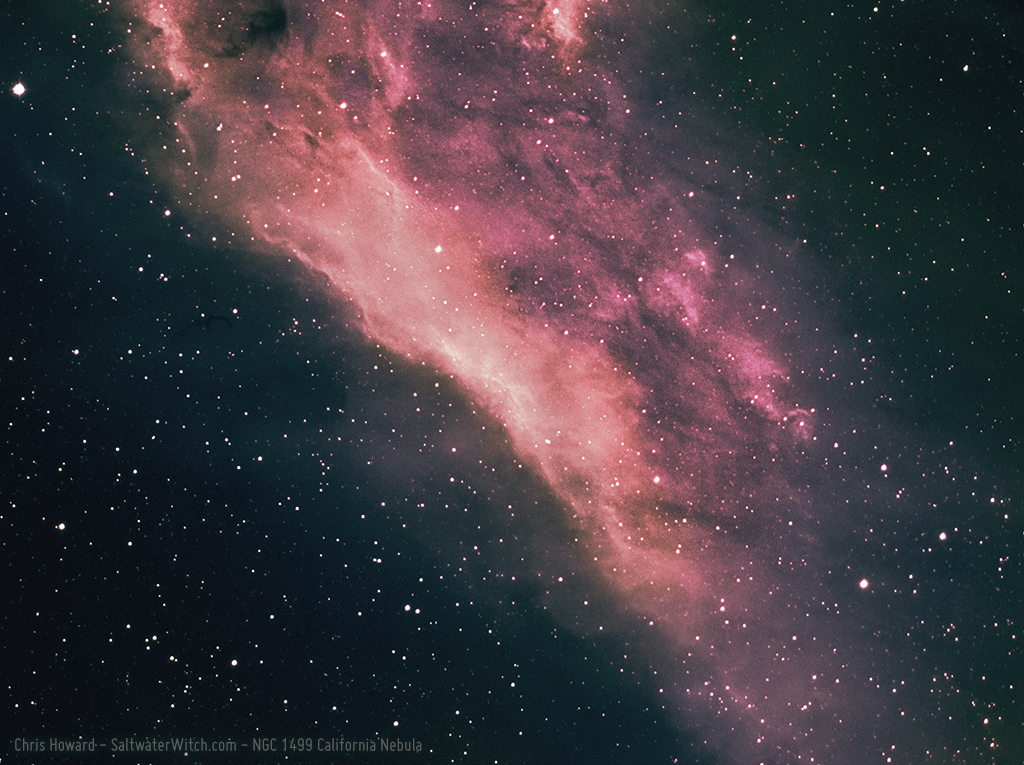
Posted December 27, 2017
Astro Session - December 26, 2017
I took several hours of hydrogen-alpha, oxygen 3, sulfur 2, and RGB images last night. Here's the color version of the Rosette Nebula (nebular region) with OIII and SII frames added to a bunch of Ha frames I shot at the beginning of the month.
Okay, this new astro setup worked well (see yesterday's post). I just bolted on the mount, did a quick polar alignment, and I was taking beautiful twenty-minute exposures of NGC 1499 (California Nebula). I shot some hydrogen-alpha of the California while waiting for the Rosette Nebular region to come into view.
I have been on this automated portable astrophotography path for a while; it's been a slow but continuous process of remote controlling my entire astro imaging rig from anywhere. I set it up, and as long as there's power and wifi, I'm good to go. This latest iteration, making the whole rig portable, is going to make things easier on those nights when I know I'll only have two hours of clear skies. Before now I wouldn't even think about setting up because that could eat up an hour alone. (Atik414Ex mono CCD, William Optics GT-81, CEM25P EQ mount, WO 50mm guidescope with ZWO ASI120S-MM guide cam, INDI/KStars/Ekos observatory control)

Four stacked 1200-second frames of NGC 1499 with the 12nm Astronomik Ha filter:

Posted December 26, 2017
Astro Session - December 26, 2017
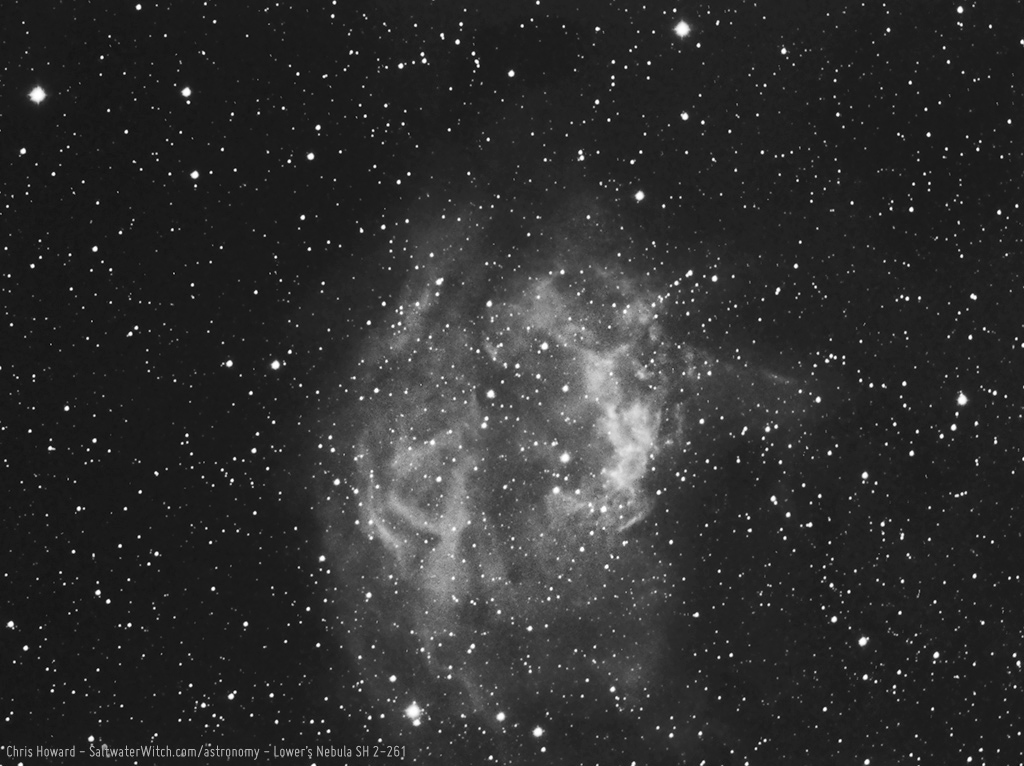 A couple test Ha frames of Lower's Nebula (SH 2-261) in the constellation Orion. I only took two exposures of Lower's Nebula while waiting for the Rosette Nebula to rise, and it reminded me of a scene in the movie Roxanne with Steve Martin (CD Bales) and Daryl Hannah (Roxanne):
A couple test Ha frames of Lower's Nebula (SH 2-261) in the constellation Orion. I only took two exposures of Lower's Nebula while waiting for the Rosette Nebula to rise, and it reminded me of a scene in the movie Roxanne with Steve Martin (CD Bales) and Daryl Hannah (Roxanne):
C.D. Bales: You must know about M31.
Roxanne: Yeah.
C.D. Bales: Now, see, I like it when they give astronomical objects names, you know, like "Andromeda" and "Saturn" and "Sea of Tranquility." This whole numbering thing is just too boring for us civilians.
Roxanne: Do you know how many objects are up there?
C.D. Bales: Well, I know it's over fifty.
That's the problem when you're a constellation like Orion, with a nebula so massive and bright you can see it clearly without a telescope (M42), or you possess dark nebular structures famously shaped like animals (Horsehead nebula, Barnard 33). You get overlooked if you're not a superstar or supernova remnant or "The Great" Orion Nebula. Yeah, that's Lower's Nebula (SH 2-261), which I'm sorry to say, I had never heard of before last night. Unfortunately that's probably because Lower's Nebula isn't the buckle on Orion's Belt. It isn't even hanging off of Orion's famous belt. It is literally out on a distant arm of the constellation--yes, Orion has one arm raised, far away from the Belt, and the famous stars like Betelgeuse, Bellatrix, and Rigel, and that's where you'll find this obscure cloud of hydrogen that doesn't even have a wikipedia page (In English. I found an Italian page for SH2-261. Nicely done, Italy.)
(Subframe info: one 600-second exposure and one 1200-second exposure stacked in DSS, no calibration frames, Atik414Ex mono CCD running at -10C, Astronomik 12nm Ha filter, William Optics GT-81, CEM25P EQ mount, WO 50mm guidescope with ZWO ASI120S-MM guide cam, INDI/KStars/Ekos observatory control)
Posted December 26, 2017
Astro Session - December 1, 2017
We were very close to a full moon last night, so my astro imaging options were limited to narrowband. I spent most of the night with Hydrogen-alpha, an inexpensive 12nm Astronomik filter, but as you can see, able to bring out some fantastic contrast, depth, and details throughout this region of interstellar ionized hydrogen. (This is the filter I currently have in the 1.25" wheel. My Baader 6nm Ha is in the 2" filter wheel)
The "Rosette Nebula" is a cluster of nebulosity that includes NGC 2237, NGC 2238, NGC 2244, NGC 2239, NGC 2246 and more. The Rosette is a bright mag 9 area of the sky about 1.3° across in the constellation Monoceros. (subframe info: 28 600 second exposures in hydrogen-alpha, no calibration frames, Atik414Ex mono CCD running at -10C, Astronomik 12nm Ha filter, William Optics GT-81, CEM25P EQ mount, WO 50mm guidescope with ZWO ASI120S-MM guide cam, INDI/KStars/Ekos observatory control). https://www.astrobin.com/324406/
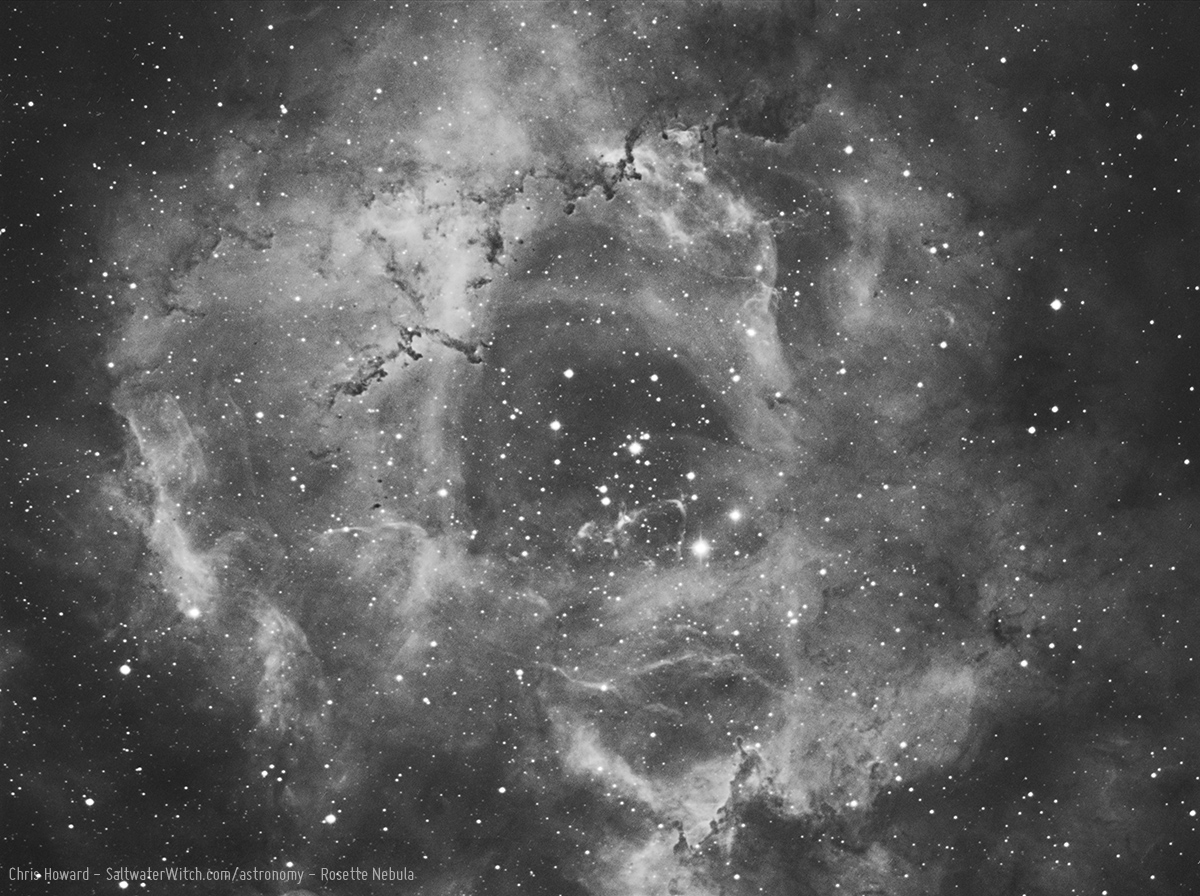
One of many reasons I love the Atik 414EX is how clean (free of noise) the light frames are when you cool the sensor down to -10C or below. I didn't shoot dark frames, or any other calibration frames last night, and didn't use any from my library when stacking.
My last target of the night: center portion of IC 2177, the "Seagull Nebula" in the constellation Monoceros. There's noise that showed up during stretching, but this one of IC 2177 is just 4 stacked Ha frames, each 600 seconds.
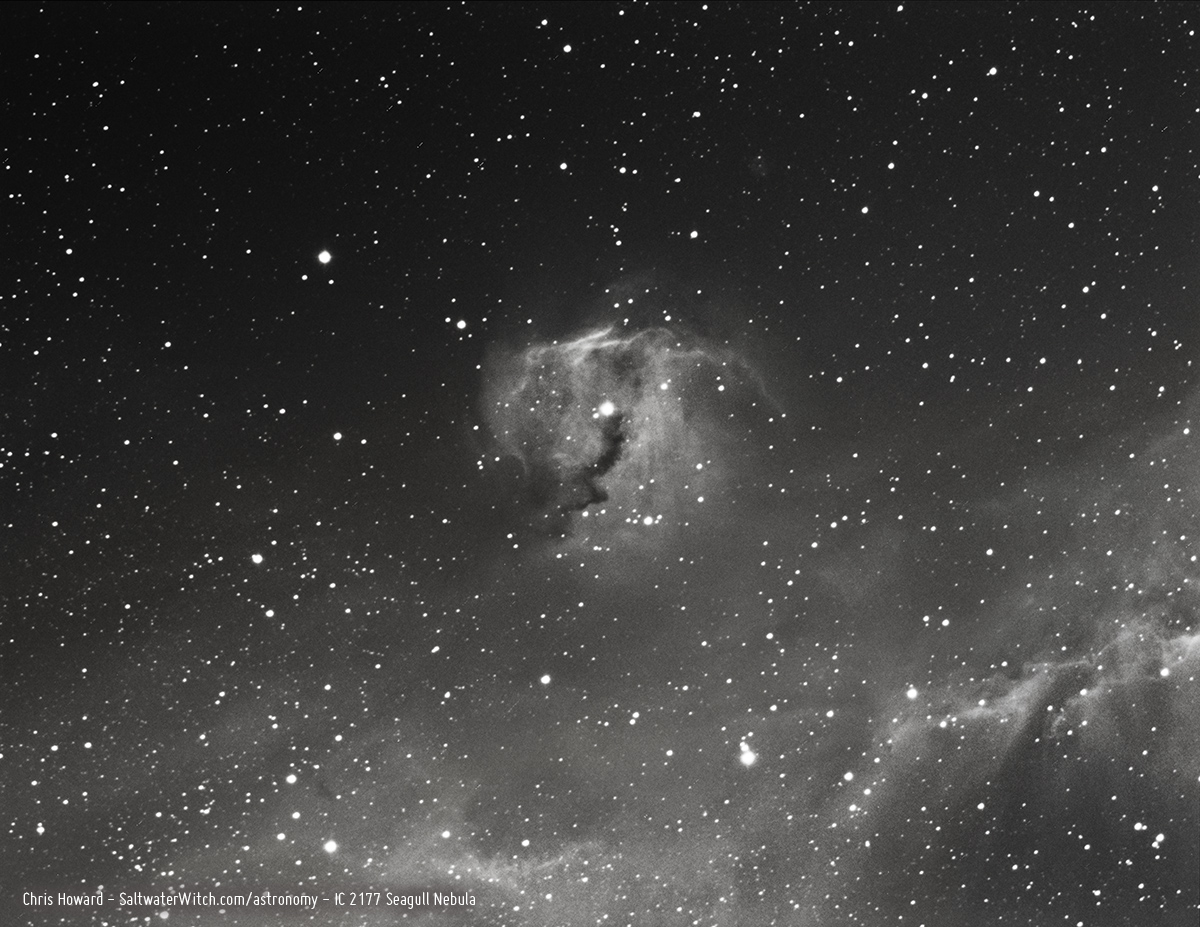
Here's a screenshot of Ekos and KStars, in the process of capturing 600 seconds of photons landing in my backyard from the Rosette Nebula. This is pretty much what I see--the tools I work with--when remotely controlling the mount, telescope, cameras, targeting, focusing, plate solving, and more. And that's what a single 600-second frame looks like. With stacking I'm obviously getting a lot more signal to noise.
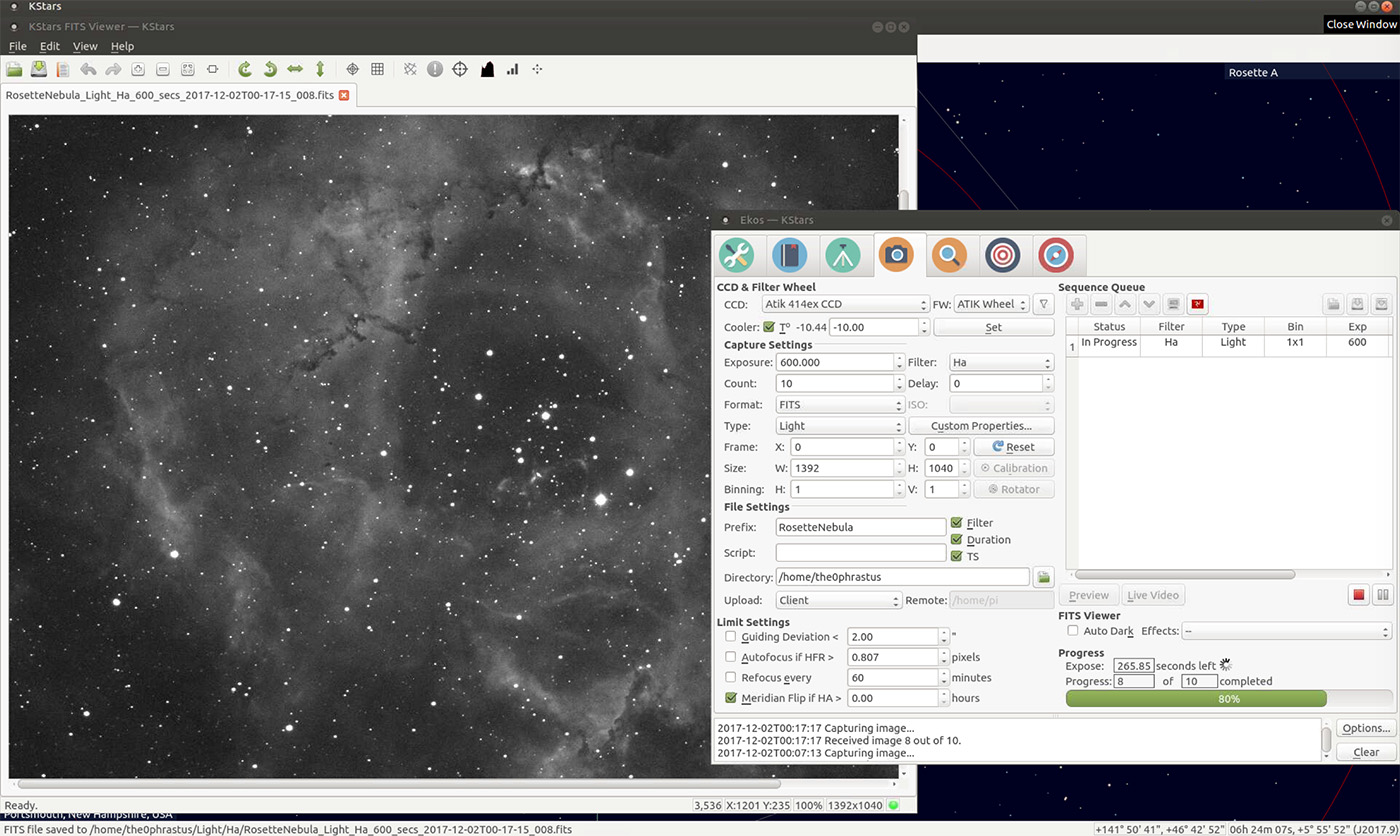
Posted December 1, 2017
Astro Session - October 13, 2017
IC 405--"Flaming Star Nebula" in the constellation Auriga, centered on the mag. +6 star AE Aurigae. It's relatively close to us, at about 1,500 light-years. This set of subframes covers the center of the fairly large nebula, which measures 37 x 19 arcminutes. (6 x 1200 second subs in Ha, O3, S2, taken with my current main setup: Atik414Ex mono CCD, William Optics GT-81, CEM25P EQ mount, WO 50mm guidescope with ZWO ASI120S-MM guide cam, INDI/KStars/Ekos observatory control).

Posted October 13, 2017
Astro Session - October 12, 2017
NGC 281 (IC 11, Sh2-184) "Pacman Nebula" in the constellation Cassiopeia. More narrowband imaging, although the moon is waning, and didn't even make into the sky until the early morning hours. I completed the subs for NGC 281 by 1am, and scheduled some narrowband exposures of IC 405, Flaming Star Nebula. (subframe info: 6 x 1200 second exposures in Ha, 5 x 1200 sec OIII & SII with 16 dark frames, Atik414Ex mono CCD, Astronomik 6nm Ha, OIII, SII, William Optics GT-81, CEM25P EQ mount, WO 50mm guidescope with ZWO ASI120S-MM guide cam, INDI/KStars/Ekos observatory control).
